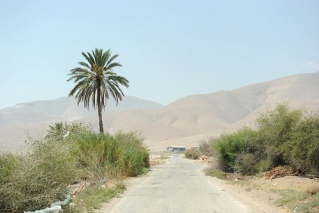 Jordan Valley, CC by Guillaume Paumier
Jordan Valley, CC by Guillaume PaumierBackground
Cardala is a small village located in the Tubas governorate of the northern Jordan Valley near Highway 90 and adjacent to the villages Bardala and Ein El-Beida. Some 320 people (40 families) live in the 17 homes of this village and engage in agriculture and raising livestock for a living. The village lands are owned by them. Cardala has existed for decades and can be found on Mandate period maps from 1935 and 1940.
Most of the structures in Cardala are homes, but a few small, auxiliary structures serve as greenhouses and one room is used as a clinic several times a week. Some houses were built with a permit from the Civil Administration in the 1980s. In the 1990s, when Israel changed its planning and construction policies with regard to Palestinian villages (see “The Prohibited Zone” by Bimkom), villagers tried to obtain permits to build more structures or add floors to existing houses, but these applications were all denied, and stop-work and demolition orders were issued for some of the structures.
In 1997, village residents petitioned the Supreme Court to halt the destruction of their homes (HCJ 5232/97). In May 2000 the head of the Civil Administration issued a final decision that the said structures in the petition would not be destroyed.
The village is connected to the electrical grid by Civil Administration permit, and connected to the water system via the neighboring village of Bardala. However, like al-‘Aqaba, another village in the northern Jordan Valley, Cardala lacks an officially recognized town plan and therefore its residents are prohibited from building any homes, agricultural structures, or public buildings, or from paving internal streets or an access road, without risking their demolition.
Cardala has no preschool, school, mosque, municipal building, or sewage system, and no means to eliminate wastewater. The improvised clinic operates, as noted, two days a week. The access road to the village from Highway 90 is a narrow dirt track, unlit and in disrepair. Villagers have to get to the neighboring villages for medical care or religious services, while their children have to traverse that distance to reach their schools.
Developments in Recent Years
In April 2010, the Association for Civil Rights in Israel (ACRI) in cooperation with Bimkom: Planners for Planning Rights appealed to the Civil Administration to prepare a town plan for Cardala, which would allow the residents adequate living conditions and development opportunities. A year later, in April 2011, the Civil Administration rejected this request on the grounds that there was no justification for the authorities to initiate planning for the village, but that if the residents submitted a plan of their own, it would be considered.
In 2011, the Civil Administration established five criteria for master plans of Palestinian towns: “size of the construction cluster”, “amount of time the construction existed”, “degree of density” (of the structures), “feasibility of public structures and infrastructure (existence or accessibility to them)”, and “proximity to nature reserves, archeology sites, roads, etc.”.
After ACRI and Bimkom were informed of these criteria, they returned to the Civil Authority head with a request to examine the possibility of preparing a town plan for Cardala. After several reminders and meetings with representatives of the Authority, the request was rejected on the grounds that Cardala is a small village, the construction there is not sufficiently dense, and that it is near two villages where development and population growth are legally permissible.
This decision seals the fate of Cardala: In the absence of basic services and development options, the village cannot survive for any length of time and will ultimately be deserted. Residents will be forced to abandon their homes and lands, and move to other villages, which will wreak severe harm on their way of life and livelihood.
Conclusions
The case of Cardala is a clear demonstration of the fact that the new criteria and, in general, the planning and construction policies of the Civil Administration do not take into consideration the life styles or welfare of the Palestinian residents in Area C. These policies and their implementation in recent decades could lead to a massive abandonment by the Palestinians of their homes and lands, and displacement to Areas A and B. A policy whereby residents are expelled from their lands is a serious violation of Israel’s obligations as the occupying power in the West Bank, including the obligation to ensure public order and the welfare of the local population.
The case of Cardala also underscores the absurdity of the Civil Administration’s policies concerning planning and construction in Palestinian villages: For years, residents of the village refrained from building without a permit to avoid breaking the law. As a result, village growth was “frozen” during that period. However, the Civil Administration’ responses to the request by ACRI and Bimkom indicate that the modest size of the village was ultimately the main reason for turning down their request for a town plan. In other words, residents of the village trapped themselves by abiding by military law.
Links
“Rights groups: State practices ‘zoning Apartheid’, YNet 24 June 2012
http://www.ynetnews.com/articles/0,7340,L-4246578,00.html
“The Prohibited Zone 2008: Israeli planning policy in the Palestinian villages in Area C” http://eng.bimkom.org/Index.asp?ArticleID=137&CategoryID=125&Page=1







